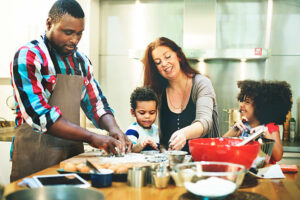Learn to Cook
go.ncsu.edu/readext?1056778
en Español / em Português
El inglés es el idioma de control de esta página. En la medida en que haya algún conflicto entre la traducción al inglés y la traducción, el inglés prevalece.
Al hacer clic en el enlace de traducción se activa un servicio de traducción gratuito para convertir la página al español. Al igual que con cualquier traducción por Internet, la conversión no es sensible al contexto y puede que no traduzca el texto en su significado original. NC State Extension no garantiza la exactitud del texto traducido. Por favor, tenga en cuenta que algunas aplicaciones y/o servicios pueden no funcionar como se espera cuando se traducen.
Português
Inglês é o idioma de controle desta página. Na medida que haja algum conflito entre o texto original em Inglês e a tradução, o Inglês prevalece.
Ao clicar no link de tradução, um serviço gratuito de tradução será ativado para converter a página para o Português. Como em qualquer tradução pela internet, a conversão não é sensivel ao contexto e pode não ocorrer a tradução para o significado orginal. O serviço de Extensão da Carolina do Norte (NC State Extension) não garante a exatidão do texto traduzido. Por favor, observe que algumas funções ou serviços podem não funcionar como esperado após a tradução.
English
English is the controlling language of this page. To the extent there is any conflict between the English text and the translation, English controls.
Clicking on the translation link activates a free translation service to convert the page to Spanish. As with any Internet translation, the conversion is not context-sensitive and may not translate the text to its original meaning. NC State Extension does not guarantee the accuracy of the translated text. Please note that some applications and/or services may not function as expected when translated.
Collapse ▲Think about how many meals you and your family cooked and ate at home last week. It’s estimated that about half of all Americans cook at home at least five meals each week. That’s great. There are lots of good reasons for doing this including improved nutrition, saving money and promoting family mealtimes.
Repeated research has shown that when people cook meals at home, they eat more fruit and vegetables. Cooking at home can be healthier because home cooked meals can contain more whole food ingredients, less preservatives and can help with special diets and allergies.
Home cooking is also great for the pocketbook. Studies have shown that preparing meals at home can save both time and money. Home cooked meals can provide leftovers for future meals and help reduce food waste.
 Cooking together as a family can help children learn useful life skills. Not just cooking but reading, planning, communication, creativity, cleanliness and problem solving. Having basic cooking skills sets the foundation for family mealtimes. Eating at home also allows sharing family cultures and traditions.
Cooking together as a family can help children learn useful life skills. Not just cooking but reading, planning, communication, creativity, cleanliness and problem solving. Having basic cooking skills sets the foundation for family mealtimes. Eating at home also allows sharing family cultures and traditions.
You may be saying, those are great thoughts, but I really don’t know how to cook. Not everyone has the knowledge or confidence in the kitchen to cook. Many people today have grown up with processed and packaged foods as well as fast-food eateries and have not learned cooking skills. We can help!
 Our Family and Consumer Science Extension Agent, Avery Ashley will be hosting an Introduction to Home Cooking series. These classes are for people with beginning to intermediate cooking skills. Don’t think you’re too old to learn. Remember, Julia Childs didn’t learn to cook until she was in her mid-30s.
Our Family and Consumer Science Extension Agent, Avery Ashley will be hosting an Introduction to Home Cooking series. These classes are for people with beginning to intermediate cooking skills. Don’t think you’re too old to learn. Remember, Julia Childs didn’t learn to cook until she was in her mid-30s.
Classes in this cooking series will start on March 6 from 5:15 until 6:45 p.m. and will continue every Thursday for five weeks. They are being held in the demonstration kitchen at N.C. Cooperative Extension at the Government Center in Bolivia.
Each week will feature a specific common cooking method, share techniques and offer meal management tips. There will be a live cooking demonstration and (of course) food samples. Participants will be given homework to do during the week. Here’s the planned topics for each week:
- March 6—basic meal planning, food safety, measuring, knife skills and using the food that’s already in your fridge or freezer. There will also be a demonstration and tasting featuring herbs and spices.
- March 12 – this week will discuss different types of rice and beans and stock and soup making. There will be a discussion about mirepoix and roux (it’s OK if you don’t know what those are—you’ll learn).
- March 20 –topics will include salads, sandwiches, tortillas, and snacks. The demo will show how to make fresh salad dressings and pan-fried tacos.
- March 27—preparing and cooking vegetables and fish. Comparison of fresh, frozen and canned foods. You’ll learn about the mallard reaction and why it makes vegetables taste better. The demo will feature roasted and sauteed vegetables.
- April 3 – the final week will feature poultry, eggs and casseroles. Poultry, eggs and Casseroles
These classes are free of charge. Participants are encouraged to attend all sessions as the skills build upon the previous week’s class. There are only twelve spots available, and we expect them to fill fast. For more information, contact N.C. Cooperative Extension here in Brunswick County at 910-253-2610.
Not a good time for you? Or not in a great location? We’re planning to take this series on-the-road throughout the county. Be watching this column and our website for details on other dates, times and locations.
Whether you’ve been cooking for years or you are brand new to cooking, you can always learn something new at a cooking class. Join in.
Cooking: the practice or skill of preparing food by combining, mixing and heating ingredients
Syracuse is a Family and Consumer Science Team Member with the N.C. Cooperative Extension’s Brunswick County Center. She can be reached by calling 910-253-2610 or email clsyracu@ncsu.edu



